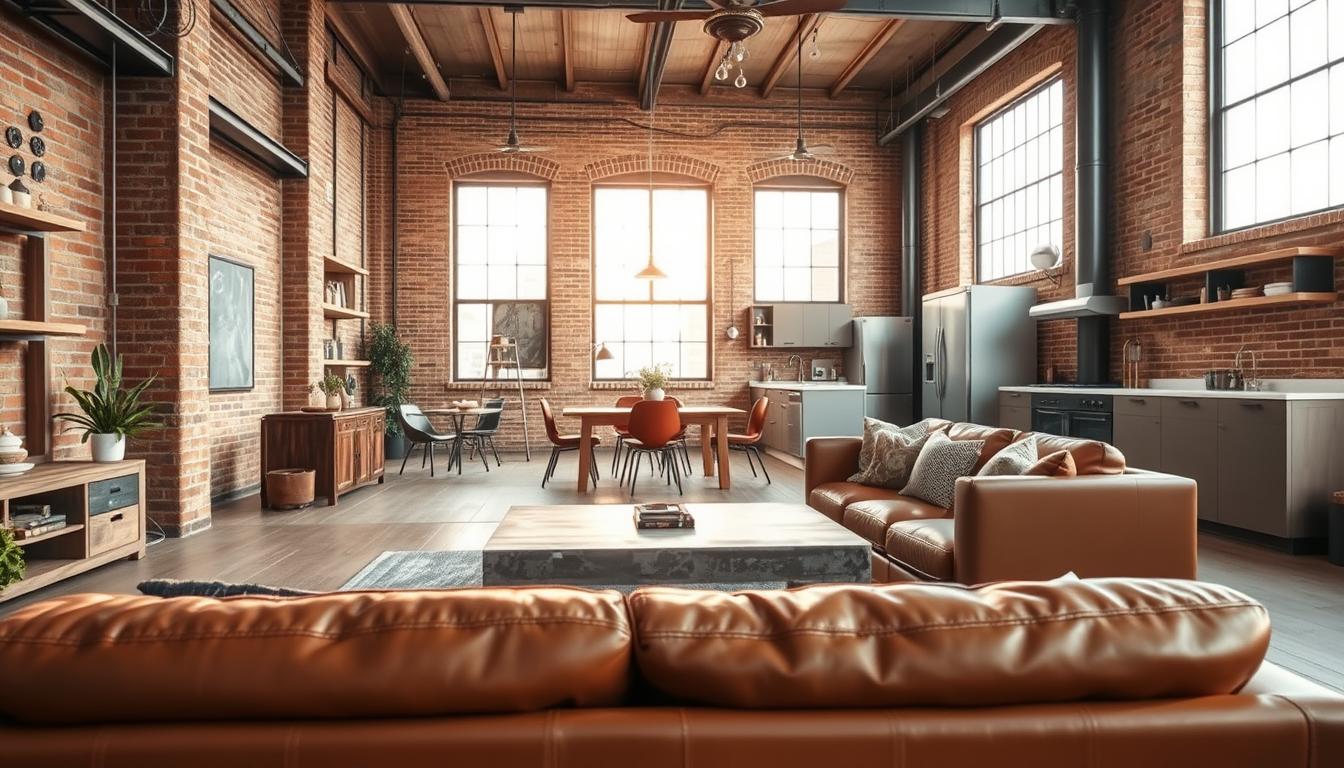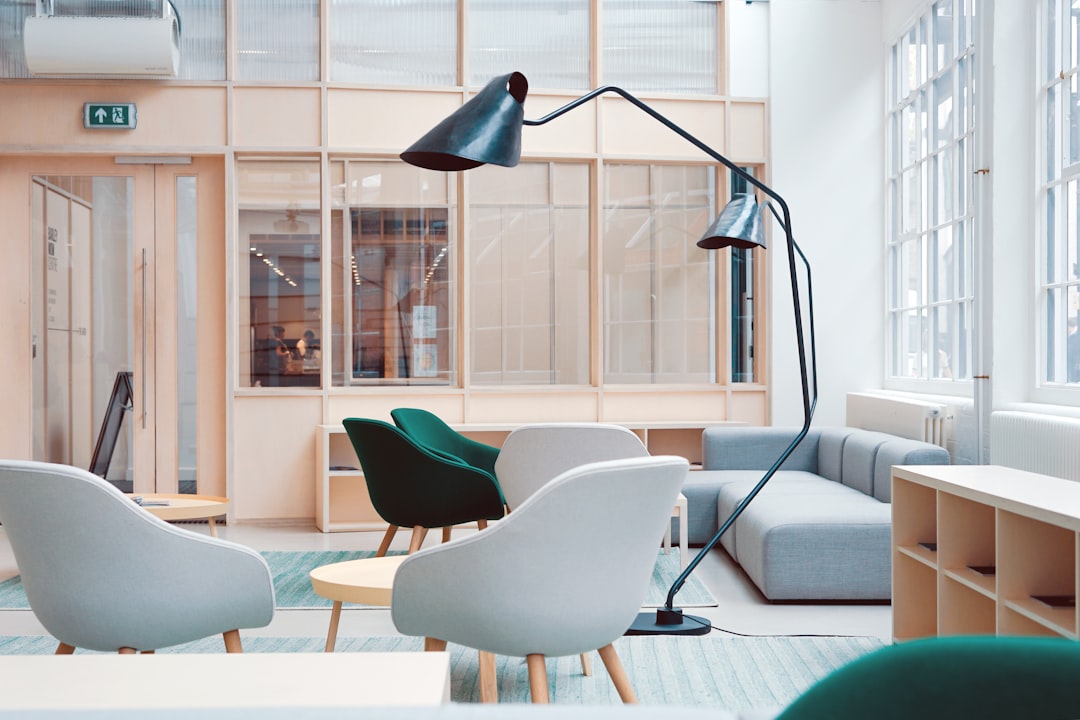Did you know industrial interior design is big in home decor today? It started in the 1960s and 1970s. This style uses exposed brick, metal, and reclaimed wood. It’s not just about looks; it makes your home functional and cozy.
Exploring industrial style decor is exciting. We’ll show you how it can make your home stylish and modern. For more on this style, check out Architectural Digest’s guide. Also, see Cozy Nest Plans’ industrial lounge for living room ideas.
Key Takeaways
- Exposed structural elements like brick walls and ductwork are characteristic of industrial design.
- Reclaimed wood and metal accents add warmth and character to a space.
- Neutral color palettes and minimal ornamentation are key to achieving an industrial look.
- Lighting fixtures like pendant lights and Edison bulbs play a crucial role.
- Balancing ruggedness with sophistication is essential to industrial chic.
What is Industrial Interior Design?
Industrial interior design comes from the industrial revolution. It focuses on function and simplicity. It turns old factories and warehouses into modern homes.
This design loves the raw and unfinished look. It uses materials like exposed brick, metal beams, and concrete. These add beauty and show off the building’s original look.
Key Characteristics of Industrial Style
Industrial style has a few key traits:
- Exposed structural elements like beams and ductwork
- Use of raw, unfinished materials
- Minimal ornamentation
- An emphasis on functionality
- Incorporation of industrial artifacts and furniture
These traits create a unique, rugged look. It’s both modern and nostalgic. As industrial chic interiors grow in popularity, designers find new ways to use these elements in homes.
History and Origins of the Movement
The history of industrial design ties back to the industrial revolution. Factories and warehouses were repurposed into homes, keeping their original features.
In the 1950s and 60s, cities like New York saw a rise in loft conversions. This trend has spread worldwide, making modern industrial design a global favorite.
| Era | Characteristics | Notable Features |
|---|---|---|
| Industrial Revolution | Raw materials, functional design | Exposed brick, metal beams |
| 1950s-60s | Repurposing of industrial spaces | Loft conversions, minimalist decor |
| Modern Era | Blend of old and new | Mix of industrial and contemporary elements |
The industrial style keeps evolving with our design tastes. It celebrates the past while looking to the future. A designer once said, “The beauty of industrial design lies in its honesty; it’s about celebrating the raw and the real.” This philosophy is why industrial design is still loved by many.
Essential Elements of Industrial Design
The heart of industrial loft design is its use of raw materials. This creates a unique look that’s both modern and nostalgic. It turns old factories and warehouses into trendy homes.
Key elements make industrial design special. Exposed brick and beams, and metal fixtures and furniture, are at the core.
Exposed Brick and Beams
Exposed brick and beams are key in industrial loft design. They add authenticity and a striking contrast to modern finishes. These elements also show the building’s history.
| Material | Aesthetic | Functionality |
|---|---|---|
| Exposed Brick | Rugged, Authentic | Structural, Visual Interest |
| Exposed Beams | Industrial, Historic | Structural, Design Element |
Metal Fixtures and Furniture
Metal fixtures and furniture are vital in industrial loft design. They add a sleek, modern touch to the space. This includes metal lighting and industrial-style furniture, creating a cohesive look.
Using these elements, homeowners can get a real industrial loft design. It’s stylish and functional.
Color Palette for Industrial Spaces
In industrial decor, the color palette greatly affects the space’s feel. Industrial spaces often stick to neutral colors. But, there’s room for creativity in color choices.
Common Color Schemes
Industrial design often uses exposed brick, metal, and concrete. These elements lead to a neutral color scheme. Shades like red, gray, and beige are common. Monochromatic tones make the space feel bigger and more connected.
Using the colors of materials as the main palette is a good approach. For example, warm brick tones pair well with cool metal tones. This creates a balanced look.
Adding Vibrant Accents
Neutral tones are the base of industrial decor. But, vibrant accents can bring personality and warmth. This can be done with furniture, lighting, or decorative items in bold colors.
A brightly colored rug or a bold piece of furniture can make a statement. It adds color and creates a focal point in the room.
- Use bold colors for accent pieces to add personality.
- Balance vibrant accents with neutral backgrounds.
- Consider the color of lighting fixtures as part of your color scheme.
Finding Inspiration for Your Industrial Interiors
To create an authentic industrial interior, mix modern and vintage elements. Industrial design is about reflecting your personality and style.
Modern vs. Vintage Industrial Styles
The industrial style has evolved into modern and vintage categories. Modern industrial style features sleek lines and minimal ornamentation. It uses contemporary materials.
Vintage industrial decor includes aged elements like reclaimed wood and antique metal. It creates a nostalgic ambiance.
Choose between modern and vintage based on your desired aesthetic. Modern industrial design is for those who like a clean look. Vintage industrial style is for those who value aged materials and history.
| Design Element | Modern Industrial | Vintage Industrial |
|---|---|---|
| Materials | Steel, Glass, Concrete | Reclaimed Wood, Antique Metal |
| Color Scheme | Neutral tones with bold accents | Earthy tones with rich patina |
| Furniture | Sleek, minimalist designs | Distressed, vintage pieces |
Online Resources and Platforms
Finding inspiration for industrial interiors is easy today. Platforms like Pinterest and Instagram are full of ideas. You can also check design blogs and websites focused on industrial design.
Use specific keywords like “industrial living room ideas” to find inspiration. Save images and create boards on Pinterest to visualize your design preferences.
By exploring these resources and understanding modern and vintage styles, you’ll create a unique industrial interior.
Important Materials in Industrial Design
In industrial design, picking the right materials is key. The materials you choose shape the look and feel of your space. In industrial interiors, some materials are preferred for their rugged and raw beauty.
Using Wood and Metal
Wood and metal are staples in industrial design. Reclaimed wood adds history and warmth. Its unique textures and imperfections are loved by designers aiming for a vintage look.
Metal, meanwhile, brings a sleek, industrial vibe. Exposed ductwork and metal beams highlight a space’s industrial roots. Metal fixtures and furniture add a rugged touch.
Incorporating Concrete and Glass
Concrete is a common choice in industrial design. Its raw quality is perfect for floors, walls, and countertops. Paired with wood or metal, it adds depth and complexity.
Glass, despite its contrast with industrial materials, adds elegance and sophistication. Large windows, glass partitions, and tables balance out the heaviness of other materials, creating a nuanced look.
| Material | Characteristics | Uses in Industrial Design |
|---|---|---|
| Wood | Warmth, texture, history | Furniture, flooring, accent walls |
| Metal | Sleek, industrial, rugged | Fixtures, furniture, beams, ductwork |
| Concrete | Raw, unfinished, durable | Floors, walls, countertops |
| Glass | Elegant, sophisticated, transparent | Windows, partitions, tables |
Furniture Choices for Industrial Spaces
Choosing the right furniture is crucial for industrial interior design. It’s all about finding a balance between looks and function.
Industrial spaces have exposed brick, metal beams, and concrete floors. Your furniture should match these features. Reclaimed wood and metal are great choices, enhancing the space’s look.
Best Brands for Industrial Furniture
Many brands specialize in industrial furniture. Here are some top ones:
- West Elm’s Industrial Collection
- Crate & Barrel’s Reclaimed Wood Furniture
- CB2’s Modern Industrial Pieces
These brands have everything from sofas to coffee tables. They all capture the industrial vibe.

Tips for Sourcing Unique Pieces
While big brands are easy to find, unique pieces can make your space special. Here’s how to find them:
- Check out local thrift stores and antique shops for vintage finds.
- Look online at Craigslist or Facebook Marketplace for second-hand furniture.
- Think about repurposing old items, like turning an old door into a coffee table.
Adding these unique items will make your industrial space truly yours.
Lighting Options to Enhance Industrial Decor
The right lighting can make your industrial home decor warm and inviting. Lighting fixtures are key in modern industrial design. They serve both function and style.
Types of Lighting Fixtures
Industrial spaces use many lighting fixtures. Each adds to the room’s feel. Some favorites include:
- Metal pendant lights, which add a touch of industrial chic
- Exposed bulb fixtures, providing a raw, utilitarian feel
- LED strip lighting, offering a modern and energy-efficient solution
These can be used alone or together. This creates a layered lighting effect that boosts the industrial look.
Layering Light in Your Space
Layering light adds depth and interest to a room. It uses different light sources. This includes overhead lights, table lamps, and floor lamps.
| Lighting Type | Purpose | Examples |
|---|---|---|
| Ambient Lighting | Provides overall illumination | Ceiling fixtures, LED panels |
| Task Lighting | Illuminates specific areas for tasks | Desk lamps, under-cabinet lighting |
| Accent Lighting | Highlights decorative features | Spotlights, picture lights |
By mixing different lights, you can make a space that’s complex and engaging. It will show off your industrial decor well.
DIY Projects to Achieve Industrial Look
To get an authentic industrial look, try DIY projects in your decor. This method adds a personal touch and supports sustainable design. It lets you use and reuse materials.
Repurposing Old Items
Adding an industrial vibe to your home is easy with old items. For example, old wooden pallets can turn into coffee tables or shelves. Metal drums can become planters or storage.
- Turn old pipes into unique lighting fixtures or towel racks.
- Use reclaimed wood to create wall art or decorative accents.
- Transform vintage machinery parts into statement pieces.
Simple Upcycling Ideas
Upcycling gives old items a new life, which is key for industrial style decor. Here are some easy ideas to start:
| Original Item | Upcycled Version | Use in Industrial Decor |
|---|---|---|
| Old metal grid | Room divider | Adds a sense of openness while maintaining separation |
| Reclaimed bricks | Feature wall | Creates a focal point and adds texture |
| Vintage factory lights | Pendant lights | Provides industrial-style lighting |
By adding these DIY projects to your decor, you create a space that shows off industrial style. It also tells a story of creativity and resourcefulness.
Tips for Balancing Comfort with Industrial Style
Making an industrial chic interior both stylish and comfy is a challenge. We can find a balance by mixing the toughness of industrial pieces with the softness of cozy furnishings.
Soft Furnishings for a Cozy Atmosphere
To warm up our industrial space, we can use soft fabrics and textures. Plush area rugs, velvet sofas, and linen curtains add comfort. They make our space cozy and inviting.
Creating Inviting Spaces
By mixing industrial elements with comfy furniture, we can make spaces perfect for relaxing. For instance, combining metal accents with soft lighting and comfy seats makes our living room warm and welcoming.
Getting the right mix of textures, materials, and furniture is key. With a bit of creativity, we can make a space that’s both stylish and comfy. It’s perfect for our industrial chic interiors.



